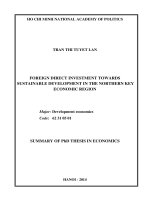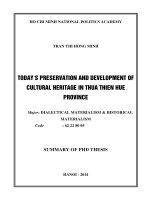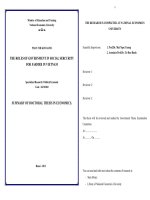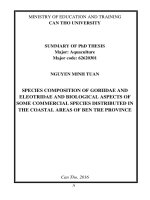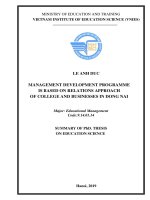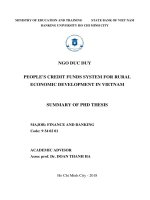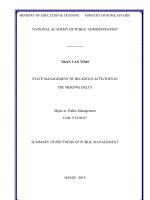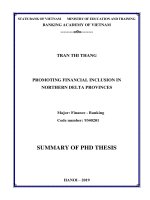Summary of PHD thesis in economics labor structure transfer by industries in thai binh at the present
Bạn đang xem bản rút gọn của tài liệu. Xem và tải ngay bản đầy đủ của tài liệu tại đây (319.61 KB, 27 trang )
HO CHI MINH NATIONAL ACADEMY OF POLITICS
PHI THI HANG
LABOR STRUCTURE TRANSFER BY INDUSTRIES
IN THAI BINH AT THE PRESENT
Major : Development Economics
Code: 62 31 05 01
SUMMARY OF PhD THESIS IN ECONOMICS
HA NOI - 2014
The thesis was finished
at the Ho Chi Minh National Academy of Politics
Academic Supervisors: 1. Assoc. Prof. Dr. Nguyen Thi Thom
2. Assoc. Prof. Dr. Nguyen Thi Huong
Judge 1: ………………………………….
………………………………….
Judge 2: ………………………………….
………………………………….
Judge 3: ………………………………….
………………………………….
The thesis will be defended in front of a panel of
examining judges at the Ho Chi Minh National Academy of Politics
At…,… …., 2014
The thesis can be found for study at the National Library and the
Library of Ho Chi Minh National Academy of Politics
1
INTRODUCTION
1. Necessity of the thesis
Labor structure transfer plays an important role in economic structure transfer.
Labor structure transfer is considered as one of important missions that serves economic
transfer. It is the result and the driving force of economic structure transfer, promoting
modernization, industrialization and helps balance the supply-demand in the labor
market. Labor structure transfer not only abides economic laws but aims to develop
sustainably, stabilize society, improve environment and develop people.
Thái Bình is a coastal province, along Red river with relatively flat terrain, which
favors economic and social development, especially marine economic development. In the
past few years, economic structure of Thai Binh has seen positive improvement. In 2001,
forestry, agriculture, fishery made up 57,6% GDP, in 2012, the figured reduced to 32,2%;
industry and construction contribution to GDP has increased. In 2001, it only counted
for 15,2% GDP, in 2012, the statistics was 34,0%; service industry contribution
increased from 27,2% in 2001 to 32,0% in 2012 [10, p. 41], [13, p. 44]. Together with
the above transfer trend, labor structure in Thai Binh also experienced the decrease in
employments in agriculture and increase in employments in industry and service. In
2001 labors in agriculture counted for 75,12% of total labors in Thai Binh, in 2012, the
number reduced to 58,3%; labors in Industry and construction increased from 13,0% in
2001to 25% in 2012; labors in service counted for 11,9% in 2001, increased to 16% in
2012 [11, p. 19], [13, p. 29].
The question is that labor structure by industries of Thai Binh is transferring at
what speed and is it appropriate with economic structure transfer of the province, does
labor structure transfer have good impacts on economic structure transfer in the
directions of modernization, industrialization? How to make labor structure transfer by
industries match with local economic structure transfer? How should the labor
structure transfer be to meet the provincial target of being an industrial province by
2020 with structure of commerce-service, industry-construction, agriculture –forestry-
fishery? To promote economic structure transfer in Thai Binh, how should labor
structure transfer?
In order to answer those questions, there is a need for a theoretical systematic
analysis of labor structure transfer by industries in general and at local level in
particular. From that, labor structure transfer by industries in Thai Binh will be
2
analyzed and evaluated to find solutions to promote the process. Originated from these
above reasons, the doctorate thesis on “Labor structure transfer by industries in Thai
Binh at the present” therefore carries theoretical and practical meanings with necessity
and importance.
2. Objectives and missions of the thesis
2.1. Thesis objectives
To evaluate the labor structure transfer by industries in Thai Binh and recommend
directions and forecast labor structure transfer by industries in Thai Binh by 2020
together with measures to be taken.
2.2. Thesis mission
- To establish theoretical system on labor structure transfer by industries at provincial
level.
- To analyze the labor structure transfer by industries in Thai Binh based on
established theory.
- To clarify achievements, limitations in labor structure transfer by industries in
Thai Binh and causes of the limitations.
- To recommend directions and solutions to promote appropriate labor structure
transfer by industries and reform economic growth model to achieve key objective of
the province of being an industrial province by 2020.
3. Research objects and scale of the thesis
3.1. Research objects
The thesis studies labor structure transfer by industries and in industry in Thai Binh.
3.2. Research scale
-The thesis focuses on labor structure transfer by industries and in industry in Thai
Binh since 2001 and orientations up to 2020. The thesis does not study labor structure
transfer by economic sectors and regions.
- The thesis studies labor structure transfer managed by Thai Binh province, does
not study freelancers and seasonal labors in the province.
4. Research methods
In order to serve research objectives and to do stated missions of the thesis,
following methods will be used:
- Marx-Lenin dialectic materialism and historic materialism.
3
- Statistics, secondary data compiling from legal sources used as basis to
compare, analyze, synthesize, evaluate labor resources, labor structure transfer by
industries. All are used to evaluate and propose solutions to promote labor structure
transfer by industries in Thai Binh.
5. New scientific findings of the thesis
- To supplement and clarify contents and criteria of labor structure transfer by
industries.
- To define and clarify factors influencing labor structure transfer by industries in
the province.
- To evaluate the labor structure transfer by industries in Thai Binh and causes of
limitations in labor structure transfer by industries in Thai Binh.
- To propose some directions and forecast labor structure transfer by industries in
Thai Binh and some feasible specific solutions to do that transfer.
6. Thesis structure
A part from introduction, conclusion, appendix, references, the thesis has 4
chapters and 10 sections.
BASIC CONTENTS
Chapter 1
LITERATURE REVIEW
1.1. NATIONAL AND INTERNATIONAL RESEARCHES ON THESIS TOPIC
The thesis generalizes national and international researches including books, articles,
scientific researches which are chronologically listed. To summary, there are three basic
directions of study:
1.1.1. Researches on labor structure transfer in general
This way, researches mostly focus on labor structure transfer, labor structure transfer
in rural areas, in Red River delta and in provinces undergoing modernization and
industrialization process. Based on the survey and analysis of labor structure transfer in
the locality, the author proposes some solutions to create jobs and to use labor resources
appropriately to meet requirements of modernization and industrialization.
1.1.2. Researches on labor structure transfer by industries by countries and
territories
4
Researches mainly analyze the state of labor structure transfer by industries in Red
river delta or nationwide, projections of the labor that need to move out of
agriculture…At the same time, many authors propose solutions to promote labor
structure transfer by industries in Vietnam, transferring labors in agriculture to non-
agriculture, laborers with low income transferring to industries with higher income…
1.1.3. Researches on labor structure transfer by industries at provincial level
Up to now, there are very few consistent and systematic works on national and
international scales on labor structure transfer at local level. Some (if any) just
mentioned labor structure transfer by industries in terms of scale, but quality.
1.2. FINDINGS RELATED TO THESIS TOPIC, ISSUE AND DIRECTIONS TO
STUDY OF THE THESIS
1.2.1. Findings related to thesis topic
Firstly, key issues of labor structure transfer by industries such as definitions of
labor structure, labor structure transfer, labor structure transfer by industries, criteria
and factors affecting labor structure transfer by industries in the directions of
modernization and industrialization of agriculture, rural areas, the role of State in labor
structure transfer in agriculture and in rural areas …are addressed.
Secondly, situations and features of labor structure transfer in rural areas of
different countries are generalized. Experience on agricultural labor structure transfer
attached to modernization and industrialization, economic structure transfer and
possibility to apply science and technology advancement in production and work
productivity is forged.
Thirdly, labor structure transfer quality in our country based on work productivity
and employment elasticity indexes is analyzed. Also, challenges of labor structure
transfer and labor structure transfer by industries are addressed.
Fourthly, labor structure transfer situations in some provinces in Vietnam such as
Bac Ninh, Da Nang, Ninh Binh, Ha Nam, Phu Tho… are analyzed, from that,
achievements, limitations and causes of limitations to labor structure transfer by
industries in these provinces are stated.
Fifthly, some solutions are proposed to push labor structure transfer by industries
in some provinces, which are completing policy mechanism related to labor structure
transfer, economic structure together with creating jobs to improve people’s income;
improving human resources quality, improving industries, professions and technology
5
that use a lot of labor to improve work productivity in rural, promoting labor export,
doing good the immigration and population and family planning.
1.2.2. Raised issues need further study
- Theoretically: To date, there has no comprehensive study on labor structure
transfer by industry and in industry in terms of both scale and quality. There has been
no study on criteria evaluating scale and quality of labor structure transfer by industries
and in industry.
- Practically: It is visible that there has been no study, analysis and evaluation of
labor structure transfer by industries and in industry in terms of scale and quality on
national, regional or local levels. For Thai Binh province, there has been no study on
labor structure transfer by industries and proposals of directions, solutions to do labor
structure transfer by industries from 2015 and 2020. That is why the topic was chosen
as doctorate thesis by the author.
1.2.3. Approach
- Approachably: the thesis studies labor structure transfer in industry in relation
to economic structure in Thai Binh from two aspects: (i) labor structure transfer by
industries in terms of scale; (ii)labor structure transfer by industries in terms of
quality.
- Theoretically: The thesis establishes theoretical system on labor structure transfer
by industries at provincial level. Specifically, it will clarify: (i) definition of labor
structure transfer by industries; (ii) contents of labor structure transfer by industries and
evaluation criteria of labor structure transfer by industries; (iii) analysis and clarification
of factors affecting labor structure transfer at provincial level.
- Practically: (i) The thesis will survey experiences of labor structure transfer of
three provinces which have similar backgrounds with Thai Binh, from that, some
lessons will be drawn for labor structure transfer by industries in Thai Binh; (ii) The
thesis will analyze and evaluate labor structure transfer by industries and in industry in
Thai Binh in terms of scale and quality based on established theory in Chapter 2; (iii)
The thesis will project labor demand with qualifications, in different economic
industries in Thai Binh from now to 2020; (iv) Based on the evaluation the current
state and projected labor demand of economic industries in Thai Binh up to 2020, the
thesis proposes directions and solutions to promote labor structure transfer by
industries in Thai Binh till 2020.
6
Chapter 2
THEORETICAL AND PRACTICAL FOUNDATION ON LABOR
STRUCTURE TRANSFER BY INDUSTRIES AT PROVINCIAL LEVEL
2.1. DEFINITION, CONTENTS AND TRENDS OF LABOR STRUCTURE
TRANSFER BY INDUSTRIES
2.1.1. Definition and contents of labor structure transfer by industries
2.1.1.1. Definition and contents of labor structure transfer by industries
From general definition of labor structure, labor structure transfer, thesis author
defines labor structure transfer by industries as follows: labor structure transfer by
industries is the process of changes in ratio and quality of labor in different industries in
a specific period of time, in a certain environment and of a certain trend.
In fact, labor structure transfer is a process in which labor is reallocated in an
advanced way to use labor effectively. That process is happening on the scale of the
whole economy and in the limit of each groups of industries, within industry. Labor
structure by industries change when there is a change in quantity and quality of labor in
that certain industry.
2.1.1.2. Contents of labor structure transfer by industries
Firstly, labor structure transfer by industries and in industry in terms on scale or
ratio in industries. By that, labor structure transfer by industries process is the process
in which labor transfers from agriculture, forestry and fishery from industry-
construction, commerce-service.
Secondly, labor structure transfer by industries and in industry in terms of
quality. By that, the process requires considerations from many aspects: (i)does labor
structure transfer by industries improve laborers’ professional skills?; (2) does labor
structure transfer by industries bring labor structure by industries more appropriate
with economic structure?; (iii) does labor structure transfer by industries improve work
productivity; (iv) does labor structure transfer by industries improve laborers’ income?
2.1.2. Trend of labor structure transfer by industries
Firstly, the trend of labor structure transfer by industries is attached to the trend of
economic structure transfer by industries. This is the most important trend of labor
structure transfer, is evident and objective to all countries undergoing the
modernization and industrialization, which is divided into periods: (i) beginning
7
period, labor in agriculture, originally just growing rice, now start growing other crops;
(ii) next period, when there is abundance in labor in agriculture, other non agriculture
production industries such as industry, craft industry and service will be invested to
attract labor in agriculture, creating the transfer from purely agriculture to labor
structure of agriculture, industry and service.
Secondly, the trend of labor structure transfer by industries attached to the
changes of economic structure. The trend reflects the change of quality of labor
resources. Based on the skills of laborers, the trend of labor structure transfer is divided
into two periods of time: (i) low period, the transfer is expressed in the increase in labor
with low-level skills and the decrease in labor with no training and education; (ii) high
period, it is the increase in labor with technical skills, artisans, labors at tertiary
education level and the decrease in labors with skills and qualifications of low level.
Thirdly, the trend of labor structure transfer in industry from sections with low
income to sections with high income. Specifically: (i) In industry: from traditional,
processing sections to high tech sections; labor structure changes in the direction from
producing products using a lot of labor to products contained greater capital and
science-technology. (ii) In agriculture, labor in growing crops reduces while labor in
raising animals or providing agricultural services increases; labor in agriculture
transfers to fishery … (iii) In service, labor in simple service sections with low added
value transfer to sections requiring intellect, technology and of high quality,
increasing laborers in these industries…
2.2. EVALUATION CRITERIA AND FACTORS AFFECTING LABOR
STRUCTURE TRANSFER BY INDUSTRIES
2.2.1. Evaluation criteria of labor structure transfer by industries
Based on analysis of contents and trends of labor structure transfer by industries
as above, the thesis author proposes two groups of criteria evaluating labor structure
transfer by industries as follows:
Firstly, first group evaluating labor structure transfer by industries in terms of scale
contains two criteria: (1) speed of labor structure transfer by industries; and (2) ratio of
labor structure transfer by industries.
Secondly, second group evaluating labor structure transfer by industries and in
industry in terms of quality has 5 criteria: (1) labor structure transfer by industries and in
industry in terms of education (qualification and professional skills); (2) relation of labor
8
structure transfer by industries and economic structure transfer by industries; (3) elasticity
index of labor curve or differences in income among industries and sections; (4) relation
of average GDP/head and labor structure transfer by industries; and (5) labor movement
in industries attached to changes in industrial work productivity.
2.2.2. Factors affecting labor structure transfer by industries at provincial level
Labor structure transfer by industry at provincial level is affected by four key
factors:
Firstly, State’s policies on labor structure transfer by industries, including strategies
and plans on labor structure transfer by industries, including, strategies, plans on labor
structure transfer in general, labor structure transfer by industries in particular and
policies on pushing labor structure transfer by industries.
Secondly, speed of modernization and industrialization, urbanization of the locality.
Thirdly, input resources such as science-technology, capital investment, labor and
natural resources.
Fourthly, other factors such as national and international labor movement;
economic growth, international economic integration; development level of output
products and services market …
2.3. EXPERIENCE OF LABOR STRUCTURE TRANSFER IN SOME PROVINCES
AND LESSONS DRAWN FOR THAI BINH
The thesis studies experience in labor structure transfer by industries in some
provinces which share similar settings and backgrounds with Thai Binh:
2.3.1. Experience of labor structure transfer by industries of Ha Nam
The thesis indicates achievements in labor structure transfer in Hanoi, which are
results of combination between solutions groups and labor structure transfer views.
Specifically: (1) Group of solutions improving labor supply, by means of establishing,
implementing family planning program, issuing policies on labor movement to allocate
labor appropriately and effectively with a focus on human resources training. … (2)
Groups of solutions improving labor demand, by means of attracting investment in
economy and society, creating stable jobs for laborers, completing and improving labor
market, developing science-technology and other sectors…
2.3.2. Experience of labor structure transfer by industries of Vinh Phuc
9
The thesis analyzes achievements of Vinh Phuc Province in labor structure
transfer by industries in the period of 2000 - 2010, which were resulted from many
solutions conducted such as promoting labor structure transfer by industries attached to
economic structure transfer in the direction of modernization and industrialization,
developing vocational training model attached to job placement for laborers especially
those from areas with farming land converted for other purposes; issuing,
implementing policies on job creation and placement, development planning of
industries together with creating jobs and labor structure transfer by industries.
2.3.3. Experience of labor structure transfer by industries of Ninh Binh
The province made a lot of efforts to promote labor structure transfer appropriately
with economic structure transfer and achieved certain achievements. The province
implemented solutions to push up labor structure transfer such as solutions groups
reducing natural birthrate; solutions group promoting economic structure transfer,
favoring the labor structure transfer and solutions group improving quality of human
resources with an emphasis on training state provincial managers, corporate managers;
training technical staff and workers, service staff; expanding the system and types of
vocational training, reforming vocational work activities and training …
2.3.4. Some lessons on labor structure transfer drawn for Thai Binh
Based on analysis of experiences of some provinces which have similar
backgrounds with Thai Binh, the thesis has drawn some lessons on labor structure
transfer for Thai Binh as follows:
Firstly, there should be consistent solutions to promote economic structure
transfer attached to job creation and placement to create the demand for labor structure
transfer by industries in the Province.
Secondly, education and training system (including vocational training) should be
coherent with development planning of industries in the modernization and
industrialization.
Thirdly, national and international associations and investment in agriculture,
rural areas and industrial parks should be expanded.
Fourthly, policies related to labor and labor structure transfer by industries should
be implemented suitably with local natural, social and economic features.
Fifthly, principles in labor structure transfer by industries should be ensured.
10
Chapter 3
SITUATION OF LABOR STRUCTURE TRANSFER IN THAI BINH
3.1. NATURAL AND SOCIO FAVORABLE AND NOT FAVORABLE CONDITIONS FOR
LABOR STRUCTURE TRANSFER BY INSDUSTRIES IN THAI BINH
3.1.1. Favorable conditions for labor structure transfer by industries in
Thai Binh
The thesis chose to analyze natural, socio conditions which have much influence on
labor structure transfer by industries in Thai Binh. Specifically,:
- Natural favorable conditions
With a convenient location, at the development triangle Hà N
ội
- H
ải Phòng
-
Qu
ảng Ninh, Thái B
ình enjoys many good conditions for growth with close economic
contact with surrounding provinces and Hanoi. The Province has strengths in fishery
with three sections of fresh water, pliohaline water, and sea water, which is great for
marine exploitation, Tien Hai gas mine with capacity of million tons of m
3
gas serving
the production of pottery, glass, paving brick, white cement….Thai Binh also has brown
coal, the shared resource of Red River Delta of big volume (about more than 30 tons).
- Socio and cultural favorable conditions
Recently, Thai Binh has seen good economic growth and economic structure
transfer. Some industries and traditional craft villages have been for hundred years. Thai
Binh’s good infrastructure and abundant labor resource has contributed greatly to the
socio development of the province.
3.1.2. Difficuties faced by labor structure transfer by industries in Thai Binh
Firstly, Thai Binh has a low economic start line with unstable economic growth,
low efficiency, quality and competiveness and it is still in the list of poor countries in
Vietnam.
Secondly, the orientation of economic development and economic structure transfer
has not been done effectively at slow speed, having not met the target set by Provincial
Party’s 18
th
Congress.
Thirdly, human resources is of low quality and unemployment rate is still high.
This is one of difficulties barring labor structure transfer by industries in Thai Binh both
in terms of speed and quality, hindering the economic development of Thai Binh.
11
3.2. SITUATION OF LABOR STRUCTURE TRANSFER BY INDUSTRIES SINCE
2001 AND ACHIEVEMENTS
3.2.1. Situation of labor structure transfer by industries and in industry in
Thai Binh in terms of scale
3.2.1.1. Changes in labor ratio by economic industries in Thai Binh
In 2005, Thai Binh had 945,9 laborers, increasing 0,66% compared with the
number of 2001(939,7 thousand people). In 2010, the figure was 1.005,5 thousand
people, increasing 6,3% compared with 2005. In 2012, it was 1012,0 thousand people.
Specifically, the changes in labor ratio are as follows:
- Changes in labor ratio in three groups of industry: Labor in agriculture, forestry
and fishery reduced from 75,12% to 60,76% and further to 58,34% from 2001, 2005 and
2012 accordingly. Labor in industry-construction increased from 12,97% (2001) to
24,12% (2010), 25,40% (2012) while labor in and commerce-service increased from ,
11,91% to 15,13% and 16,26% in 2001, 2010 and 2012 respectively.
The labor structure transfer by industries in Thai Binh is shown in the following table:
Table 3.1: Total number of laborers and labor percentage in economic
industries in Thai Binh from 2001 - 2012
Unit: thousand people
Comparision (%)
Criteria
2001
2005
2007
2009
2010
2011
2012
2005/2001
2010/2005
Total
laborers
939,7
945,9
994,1
949,8
1.005,5
1.010,1
1.012,0
+ 0,66
+ 6,30
Percentage
(%)
100,00
100,00
100,00
100,00
100,00
100,00
100,00
Laborers in
agriculture,
forestry and
fishery
705,9
629,7
640,2
601,4
610,9
600,0
590,4
- 10,79
- 2,99
Perc. (%)
75,12
66,56
64,40
63,32
60,76
59,40
58,34
-8,56
-5,80
Laborers in
industry-
construction
121,9
190,0
209,3
203,6
242,5
252,1
257,1
+ 55,87
+ 27,63
Perc. (%)
12,97
20,09
21,05
21,44
24,12
24,96
25,40
+ 7,12
+ 4,03
Laborers in
commerce-
service
111,9
126,2
144,6
144,8
152,1
158,0
164,5
+ 12,87
+ 20,43
Perc. (%)
11,91
13,35
14,55
15,25
15,12
15,64
16,26
+ 1,44
+ 1,77
12
Source: Yearly statistics of Thai Binh in 2007,2011, 2012 and author’s own caculation
- Changes in labor percentage within a group of industries:
+ In agriculture, forestry and fishery: In 2001, labor in agriculture counted for
99,5% of total number of laborers in agriculture, forestry and fishery. The figure
reduced to 95% in 2010 and 2012; labor in fishery, from being not listed in the
statistics with small number in the period of 2001-2005, in 2010, it counted for 0,23%
and in 2012, 0,44%; labor in fishery increased from 0,45% in 2001 to 4,28% in 2010,
and increased to 3,63% in 2012.
+ In industry-construction: in 2001, there were 90,3 thousand laborers in
processing and manufacturing industries, equivalent to 74,06%. In 2010, the number
increased to 188,3 thousand people (77,65%) and in 2012, 198,84 thousand people
(77,35%); labor in electricity production and distribution …, water provision and waste
management and treatment, in 2001, counted for 0,82% and 0,08%, in 2012, 1,03% and
0,4%; labor in construction greatly reduced from 24,06% in 2001 to 20,45% and
20,63% in 2010 and 2012.
+ In commerce-service : almost of sections in the industry witnessed an increase
(relative and absolute) in the number of laborers. The accommodation and eating service
had 2,4 thousand people in 2001, 12,2 thousand people in 2010 and 13,85 thousand
people in 2012, with corresponding percentages were 2,14%, 8,02% and 8,42%; labor
in estate increased from 0,63% (2001) to 1,27% (2012); similarly, laborers in science
and technology increased from 0,09% to 0,95%; labor in housekeeping increased from
1,25% to 5,06%; labor in logistics and transportation increased from 5,9% to 7,3% in
the same period of time. Some industries experienced slight increase such as
automobile, motorbike wholesale, retail, maintenance. Some got slight decrease in
laborers such as arts, entertainment and other services.
3.2.1.2. Labor structure transfer by industries ratio in Thai Binh
With Vector method, Cos , we can quantify the level of labor structure transfer
by industries in Thai Binh from 2001 to 2012 as follows:
Table 3.2: Labor structure transfer by industries ratio in Thai Binh
from 2001 - 2012
Unit: %
Year
01- 02
02- 03
03- 04
04- 05
05- 06
06- 07
07 - 08
08- 09
09 -10
10-11
11-12
n
1,7133
1,7140
1,7140
1,7135
1,7144
1,7143
1,7145
1,7145
1,7129
1,7142
1,7144
In the period of 2001 - 2002 to 2007 - 2008, labor structure transfer by industries
ratio of Thai Binh saw not not many changes, which reflected that the changes in labor
percentage in industries were not many, in 2009 - 2010, the ratio was at the lowest
13
point, 1,7129% (due to labor force suddenly decreased 44,9 thousand people, from
997,7 thousand in 2008 to 949,8 thousand in 2009). In the period of 2001- 2012, labor
in industries transferred from agriculture, forestry and fishery to industry-construction
and commerce-service.
3.2.2. Situation of labor structure transfer by industries and in industry in
Thai Binh in terms of quality
The evaluation of labor structure transfer by industries quality is often based on
following criteria:
3.2.2.1. Changes in qualification and professional skills of laborers by industries in
Thai Binh
- Qualification and professional skills of laborers by industries in Thai Binh
The period of 2002 – 2011 saw significant change in laborers’ literacy and
qualification. The number of illiterate laborers dramatically reduced, almost one third,
from 0,9% to 0,31%; the number of primary school leavers reduced half, from 24% to
12%; the number of secondary school leavers increased from some 60% to about 67%
and the number of high school leavers increased from 15% to 22%. This showed that
laborers’ literacy and qualification improved a lot, they have more chances to access,
improve their technical and professional skills, thus job placement and labor structure
transfer became effective.
For professional and technical skills: the percentage of people having no skills
significantly reduced, from 76,08% (2002) to 70,05% (2005) and to 62,38% (2011);
the percentage of people undergoing training of primary level went up from 16,96% in
2002 to 19,37% in 2005 and 21,64% in 2011; the percentage of laborers with
intermediate and collegial levels upwards increased from 6,95% in 2002 to 10,57% in
2005 and 15,98% in 2011.
- Qualification and professional and technical skills of laborers within industry in
Thai Binh
+ Transfer in agriculture, forestry and fishery: labor in agriculture, forestry and
fishery without training, qualifications, certificates slowly reduced, in 2005, 97,59%
and in 2011, 96,34%; labor with primary-level training increased from 0,85% to 1,5%
in 2011; labor with intermediate level training upwards increased slowly, from 1,56%
in 2005 to 2,16% in 2011. Most of laborers in agriculture, forestry and fishery do not
have training or just have less than three month training course (about 96-97%), which
hindered greatly the labor structure transfer from agricultural industries to non
agricultural industries.
14
+ Transfer in industry-construction: the number of laborers at under intermediate-
level training held high percentage, in 2001, almost 78% , in 2005, almost 76,5% in
2010, 69,5% , in 2011, 68,3%. For laborers with intermediate-level training, in 2001-
2005, the group made up 75- 80%, in 2010 – 2011, 69,5%; laborers with collegial level
training counted for 21,68% in 2001, reducing to 19,2% in 2005, increasing to some
22,5% in 2010-2011, laborers with university –level training increased from2,63%
(2001) to 7,5%, (2010 - 2011), the increase, however, was still low compared to
national level.
+ Transfer in commerce-service: qualification and training levels of labor in
commerce-service in Thai Binh underwent significant changes. In 2005, number of
laborers having no training or primary training counted for 68,2%, in 2011, the group
just counted for 54,61%; labor with intermediate level training greatly increased, from
31,8% to 45,39% in the same period (increase of 13,6%). The percentage of people at
collegial training level had the highest increase 1,23% lên 2,83%; other groups had 1.3
to 1.6 increase. Specifically, percentage of vocational intermediate laborers increased
from 5,33% to 7,1%, academic intermediate training, from 7,23% to 11,89%; collegial
and university level, from 8,01% to 23,57%.
3.2.2.2. Relation of labor structure transfer by industries and labor structure
transfer in industry in Thai Binh
In Thai Binh in 2001 - 2012, agriculture, forestry and fishery contribution to GDP
reduced 25,4% (on average, about 2,2% each year), industry-construction contribution to
GDP increased 18,7% (1,7%/year on average), commerce-service contribution increased
5,27% (0,5%/year on average). Meanwhile, ratio of labor in agriculture, forestry and
fishery yearly reduced 1,68%, ratio of labor in industry-construction increased 1,04%, and
that in commerce-service increased 0,37%. Also in this period, the GDP transfer and labor
structure transfer in agriculture, forestry and fishery was of the same direction. GDP of
agriculture, forestry and fishery reduced greatly while labor in agriculture, forestry and
fishery reduced more slowly. GDP transfer of industry-construction increased quickly,
same with labor in industry-construction though the second did not enjoy the same speed.
The commerce-service GDP and labor in commerce-service had relatively equal
increase.From above analysis, it is obvious that the speed of labor structure transfer by
industries in Thai Binh in the studied period of time did not keep up with transfer of
industries in GDP, which made the number of laborers moving slowly from agriculture,
forestry and fishery to industry-construction and commerce-service. Especially, the
transfer to industry-construction was really slow, the non farming time was still long,
impeding work productivity, low income and slow development of the locality.
15
3.2.2.3. Elasticity index of labor supply by income
Elasticity index of labor supply by income of the Province in 2001-2012 was not
stable . It reached the peak in 2008, at 1,6626%, and the lowest point in 2002 at -
0,8961% and in 2010, 0,2932%. This shows that labor supply did not grow stably and the
labor structure transfer by industries in Thai Binh, despite of going in the direction of
modernization and industrialization, reducing labor in agriculture, increasing labor in non
agriculture industries, the labor structure transfer was not sustainable. In 2008, the highest
elasticity index reflected the difference in income of labor in agriculture with labor in
other industrial, which led to the fastest labor transfer from agriculture to non agriculture
industries in the period of 2001-2011.
3.2.2.4. Labor movement in industries attached to work productivity change by
industries
Table 3.3: Work productivity by industries in Thai Binh
in the period of 2001 - 2012
Unit: million dong/capita -compared price in 1994)
Comparison(%)
Criteria
2001
2005
2010
2011
2012*
2005/2001
2010/2005
Overall
5,087
6,577
11,357
12,449
33,818
+ 29,30
+ 72,67
Work productivity in
agriculture, forestry
and fishery
3,900
4,809
6,464
6,870
18,931
+ 23,31
+ 34,42
Work productivity in
industry-construction
5,969
6,841
16,095
17,798
45,788
+ 14,61
+ 135,26
Work productivity in
commerce-service
11,613
14,995
23,452
25,101
68,535
+ 29,12
+ 56,40
Source: [10, tr. 34], [12, tr. 41, 42], [13, tr. 44 and author’s calculation]
* Work productivity in of Thai Binh in 2012 was calculated using compared price
of 2010.
From table 3.1 and table 3.3, the relation between labor transfer and change in
work productivity can be calculated. In 2001 - 2005, when labor in agriculture, forestry
and fishery reduced 8,56%, the industry work productivity increased 23,31%, thus, we
can see that one 1% decrease in labor in agriculture, forestry and fishery led to 2,72%
industry work productivity; for industry-construction, labor increased 7,12% while
work productivity increased 14,61%, each 1% increase in labor led to 2,05% increase
in work productivity; similarly, for commerce-service, 1% increase in labor of the
industry led to 20,22% increase in work productivity. With the same calculation for the
period of 2005 - 2010, 1% decrease in labor in agriculture, forestry and fishery
resulted in 5,94% increase in work productivity; 1% increase in labor in industry-
16
construction resulted in 35,56% increase in work productivity; and for commerce-
service, 1% increase in labor in commerce-service led to 31,86% increase in work
productivity. From above analysis, we can see that, in 2001-2005, in the labor structure
transfer of the province, labor transfer of commerce-service was not much but brought
high work productivity, while the other industries agriculture, forestry and fishery and
industry-construction witnessed much labor transfer but slight increase in work
productivity. In the period of 2005 – 2010, the transfer of labor in different industries
had more improvements, especially in industry-construction and commerce-service. In
2011 compared with 2010, ratio of agriculture, forestry and fishery labor decreased
1,36% (equivalent to 10,9 thousand laborers) but work productivity increased to 0,406
million dong/head; labor in industry-construction increased 0,34% (equivalent to 9,6
million laborers), its work productivity increased to 1,703 million dong/head; labor in
commerce-service increased 0,52% (equivalent to 5,9 thousand laborers), its work
productivity increased to 1,649 million dong/head.
3.2.2.5. Relation of GDP per capita and labor structure by industries in Thai Binh
In 2012, GDP per capita of Thai Binh was 24 million dong, equivalent to 1.133
USD/ per capita/year, labor ratio of industries of Thai Binh would be (according to
economists’ study): labor in agriculture, forestry and fishery counted for 46,5%; labor
in industry-construction 22,5%; and labor in commerce-service 31,0%. However, labor
structure by industries of Thai Binh in 2012 was 58,34% for agriculture, forestry and
fishery, 25,40% for industry-construction and 16,26% for commerce-service. This
shows that increase of GDP per capita/year and labor structure transfer by industries of
the Province was not appropriate. The labor structure transfer was slow, labor in
agriculture, forestry and fishery was too high while that of commerce-service was low.
3.3. LIMITATIONS OF LABOR STRUCTURE TRANSFER BY INDUSTRIES IN
THAI BINH AND CAUSES
3.3.1. Limitations in labor structure transfer by industries in Thai Binh
Firstly, labor structure transfer by industries in Thai Binh was slow, expressing in
following points:
(i) The speed of labor structure transfer by 3 groups was slow (set target was that by
2010, the ratios of labor in agriculture, forestry and fishery, industry-construction and
commerce-service were 53%, 30% and 17% respectively; while the actual figures in 2012
were 58,34%, 25,40%, and 16,26%).
(ii) The speed of labor structure transfer in industry was slow, especially in
agriculture. It was because of unclear clarification of sections (one household could be
17
the subject of farming and breeding sections at the same time, it means that the household
has farming land, has land to raise pigs and also has ponds to raise fish). Furthermore,
the low level of specialization of labor in agriculture in Thai Binh as well as in other
provinces in Red River Delta added to the slow labor structure transfer by industry and
unclear labor structure.
Secondly, the trend of labor structure transfer by industries was not suitable and
did not meet requirements of economic structure transfer in the direction of
modernization and industrialization and integration. Labor structure transfer byu
industries in Thai Binh so far attached to the change in professional skills yet still very
limited. The ratio of labor with training was 42%, but labor with vocational training just
counted for 29%, it means that quality of labor structure transfer by industries was not
high, most of laborers were unskilled . Within agriculture industry, labor from rural
areas were mostly seasonal with low specialization. There was no clear role of goods
market economy, the production was of small scale with low productivity, low
business efficiency, affecting the process of modernization and industrialization of the
countryside as well as the development of new rural areas of the Province.
Thirdly, the labor structure transfer by industries was of low quality, expressed in
following points:
(i) labor structure transfer by industries in Thai Binh has not brought high work
productivity while general work productivity in the period of 2005 - 2010 increased
almost 72,7%, that of industry-construction increased 135,3%, commerce-service work
productivity only had 56,4% increase, and that of agriculture was only 34,4% increase.
To date, work productivity by industries was 12,45 million dong/head/year, of which
work productivity of agriculture was lowest, at 6,87 million dong/head/year, industry
work productivity was 17,79 million dong/head/year and service work productivity was
25,10 million dong/head/year.
(ii) Labor structure transfer by industries in the Province did not ensure job
placements and liberate manual work for laborers. The level of labor in full use was low.
Labor structure transfer by industries has not ensured employment for people at
working age, has not really liberated laborers from manual work to promote the role of
labor resource in economic development. At the moment, the time using labor in
agriculture is 75%. In 2012, unemployment rate of the whole province was 2,15%, in
urban area, the rate was relatively high, 12%. Job placing for laborers who lost farming
land by changing to another jobs, moving labor to other industries was not effective,
not stable and seasonal.
18
(iii) Labor structure transfer has not utilized the ready advantages as well as
protected local environments. Despite of the advantage of being a coastal province
with labor abundance, agriculture, forestry and fishery products of the province are not
outstanding. People often know about H
ải Hậu
rice, Giao Th
ủy
oyster… as famous
brands nationally and internationally, but not any agricultural products from Thai Binh.
Also, the natural resources conservation was not effective. In raising marine products,
the transfer from growing rice to raising shrimps was done massively without being
planned, which led to farming land turned salt, causing difficulties for rice growing…
the oyster growing was too heated, leading to difficulties in diseases prevention and
low productivity
3.3.2. Limitations causes
Firstly, the lack of planning and policy promoting labor structure transfer by
industries. For a long time, Thai Binh and other provinces in Red River Delta in particular
and in the whole country in general had no plan on human resources and labor structure
transfer in an effective way. Recently, Thai Binh has drafted the planning on human
resources in the period of 2011 – 2020. It was approved in July 2012. The Province lacks
many policies promoting labor structure transfer by industries. Some issued policies were
not very effective, inappropriate and inconsistent such as policies favoring and supporting,
attracting investors into industrial parks, industrial complex; policy on compensating,
converting land use purposes , policy on farming land planning
Secondly, the speed of modernization and industrialization, integration,
urbanization of the Province was slow. Industrial parks and complex were not
developed. Urbanization speed was slow. Urbanization process did not equally develop
in different areas, mostly focused in Thai Biinh city, other towns were small with low
population density, limited socio infrastructure, urban areas were established in terms
of administration only without attaching to economic development.
Thirdly, resources promoting labor structure transfer by industries of the
Province were limited: human resources training of low quality, especially vocational
professional training, capital market activities were limited, capital investment mostly
was from national projects, financial institutions were not diversified and flexible. The
applications of science-technology advancement were limited, there were not enough
competent people in professions and management.
Fourthly, other factors: narrowed import activities; labor export facing
difficulties….which all increased pressure for job creation, placement, social security
in locality.
19
Chapter 4
ORIENTATIONS AND SOLUTIONS TO PROMOTE LABOR STRUCTURE
TRANSFER BY INDUSTRIES IN THAI BINH BY 2020
4.1. ORIENTATIONS AND PROJECTIONS O N LABOR STRUCTURE
TRANSFER BY INDUSTRIES IN THAI BINH UP TO 2020
4.1.1. Orientations of labor structure transfer by industries in Thai Binh up
to 2020
Firstly, increasing ratio of labor in industry-construction and commerce-service
(especially processing section with high added value), reducing ratio of labor in agriculture,
developing areas with specialized crops, developing farming with high intellect to improve
work productivity in agriculture.
Secondly, attaching labor structure transfer by industries to economic structure
transfer by industries up to 2020.
Thirdly, attaching labor structure transfer by industries to economic growth model,
mostly from horizontal model to vertical and horizontal model.
Fourthly, attaching labor structure transfer by industries to job creation, placement
and laborers’ income.
4.1.2. Projections of labor structure transfer by industries in Thai Binh up
to 2020
From analyzing domestic and international settings which affect the projections
of labor structure transfer by industries in Thai Binh, the thesis projects labor demand in
Thai Binh up to 2020, including projections about labor supply and demand in Thai
Binh until 2020, projections about labors with vocational training in Thai Binh and
projections about labor structure transfer by industries until 2020. By that, in order to
have enough human resouce requirements for labor structure transfer by industries in the
direction of modernization and industrialization and international integration, following
targets should be set: ratio of labor with training of 55% in 2015 and 70% in 2020, in
which labor with vocational training of 41,5% and 56,5% for 2015 and 2020
respectively; projected number of laborers in 2015 and 2020 is nearly 612 thousand
people and 776 thousand people, of which laborers with vocational training will be
about 462 thousand people and 626 thousand people.
The thesis projects labor structure by three industry groups in 2015, which are
47,8% labor in agriculture, forestry and fishery; 33,4% labor in industry-construction
20
and 18,8% labor in commerce-service ;similarly, the structure in 2020 is 38,5%; 40,3%
and 21,2%.
4.2. SOLUTIONS PTOMOTING LABOR STRUCTURE TRANSFER BY INDUSTRIES
IN THAI BINH UP TO 2020
4.2.1. Solutions group promoting labor structure transfer by industries in the
direction of modernization and industrialization and international integration of
the locality
To promote labor structure transfer by industries in the direction of modernization
and industrialization and international integration, Thai Binh Province needs to do
following tasks:
Firstly, promoting modernization and industrialization in the locality based on
utilizing potential and advantages to push up industrial development, focusing to
establishing complete infrastructure with 6 industrial parks, 30 industrial complex
which are carefully planned; continuously promoting the development of industries,
craft, trade villages in the city and towns; promoting the call for investment, creating a
favorable environment for industrial development in the province; pushing up trade
promotion, positively supporting farmers in consumption via business contracts;
promoting and improving the quality of banking activities; expanding and developing
the network and services of new banks
Secondly, speeding up the urbanization and international integration via
developing urban areas, densely populated locations; planning land use; developing
economic routes, developing central system of the province developing coastal
areas…in the direction of modernization and industrialization and international
integration at the locality.
4.2.2. Solutions group creating resources promoting labor structure transfer
by industries in the direction of modernization and industrialization,
urbanization and international integration
To promote labor structure transfer by industries in the direction of
modernization and industrialization, international integration, there should be input
resources such as capital, labor, science, technology. To create these resources, Thai
Binh needs to do following tasks:
Firstly, improving the quality of human resources and developing labor market
to meet requirements of economic structure transfer of the Province. This solution
needs to be focused and carried out at breakthrough level because of the essentiality of
laborers’ intellect, qualifications, professional skills in the sustainable transfer of labor
in agriculture to non agriculture industries. Solutions need to be implemented are:
21
improving profession, literacy, professional skills, especially vocational training;
developing labor market to adhere the labor supply and demand.
Secondly, utilizing and improving the efficiency of capital for socio
development of the Province. Specific solutions base on capital sources and types,
national capital, international capital and further developing types of credit for people
changing their jobs.
Thirdly, improving the applications of science-technology advancement into socio
development of the Province in the direction of improving activities promoting
agriculture, forestry and fishery and agricultural services to bring science and
technology, new techniques, especially biological technology with breeding trees and
animals of high productivity into production and trading; improving processing industry
with growing fresh products, fishery, agricultural products, vegetables, fruits of the
Province; combining upgrading current technology, that using laborers with advanced
technology to meet requirements of the market, improving IT applications, reforming
organization methods with scientific management with services industries to expand and
improve service quality
4.2.3. Solutions group completing and implementing policies promoting labor
structure transfer by industries
To promote positive influence of policies to speed up labor structure transfer
suitably, quickly and sustainably, Thai Binh need to complete and implement
effectively some following policies:
Firstly, investment attraction policy. The province needs to supplement some policies
encouraging investment in agriculture at the depth, applying widely biological technology,
scientific achievements on agricultural products breeding, storage, processing and
irrigation system…; improving complete investment in industrial parks, industrial
complex, traditional professional villages in towns and city in Thai Binh according to
the planning; encouraging, supporting capital and interest rate for small and medium
enterprises on production, trading and industries attracting many laborers and creating
jobs; continuously implementing policies on infrastructure development to serve labor
structure transfer best
Secondly, policies developing industries. The Province needs to implement
wholly, consistently policies developing agriculture, forestry and fishery, industry-
construction and commerce-service. In addition, Thai Binh needs a marine economic
development strategy attached to real settings of the Province such as: policy on
human resources training ( for agriculture, industry and tourism ) attached to marine
22
economics, policy developing supplementary industries, farming and breeding,
exploiting, processing fishery products attached to marine economics
Thirdly, land policy. Together with implementing regulations in Law on Landin
2003, guidance decrees…Thai Binh issued many legal documents. In the coming time,
policies on land compensation, support for job, job creation should be completed in the
direction that: (i) compensation for households in city differs that for households in rural
areas; (ii) compensation, support, resettlement principles must observe legal regulations,
yet the authority should take changes in economics and confiscated land as assets into
consideration; (iii) support, compensation, resettlement competency of consulting
organizations, committees, districts and city should be improved; (iv) there should be a
long term plan for financial source to do the compensation, resettlement support; (v)
compensation, resettlement support policies should be consistent and coherent to avoid
different levels of support and compensation of different projects and works.
Fourthly, human resources development policy. Thai Binh needs to effectively do
the “planning and development of human recourses in Thai Binh in the period of 2011 -
2020”, to develop the human resources both quality and quality to increasingly meet the
requirements of modernization and industrialization and international integration.
Policies attracting and using talented people and people of high professional level should
be completed and implemented to limit the brain drain. . The mechanism evaluating
human resources should base on real competency, skills, knowledge, attitude which are
all expressed in their work performance. Policies for labors of different professional
levels, attitude and skills should be different.
Fifthly, job creation and placement policy.Thai Binh needs to ensure policies on
insurance, subsidy, accommodation, training and re training for laborers to be done well.
At the same time, laborers with new ideas in production, trading, should be encouraged
and motivated together with policy attracting talented people… Employment strategy of
the Province should be closely attached to job creation and placement for people losing
land. Thus, all resources should be emphatically exploited to speed up economic
development and create more jobs. The Province needs to conduct surveys on
employment and jobs to supervise, guide organizations and individuals using labor to
observe well regulations on labor management, Labor code, policies applicable to
laborers, especially those who get land confiscated. Thai Binh also needs to manage well
funds for hunger alleviation, poverty reduction, job creation; funds for training,
supporting, providing vocational training for laborers; funds supporting people to find
jobs and labor supply
23
CONCLUSION
With the topic of: “Labor structure transfer by industries in Thai Binh in the
current time”, the author initially studied and clarified some theoretical and practical
issues on labor structure transfer by industries. Here are some findings of the thesis:
1. Labor structure transfer by industries is the changing process of ratio and
quality of labor in different industries in a specific period of time and space in a certain
trend. In fact, labor structure transfer is the process relocating labor in the economy in
the advance direction to use labor efficiently. The process occurs on the whole
economic scale and individual industrial groups’ scale and in industry.
2. Labor structure transfer by industries is evaluated with two groups of criteria:
Firstly, the group evaluating labor structure transfer by industry and in industry in terms
of scale or ratio of industries, with two criteria: (1) Speed of labor structure transfer by
industries; (2) transfer ratio of labor structure; Secondly, the group evaluating labor
structure transfer by industries and in industry in terms of quality, with 5 criteria: (1)
Labor structure transfer by industries and in industry in terms of qualifications and
professional skills; (2) Relation of labor structure transfer by industries and economic
structure transfer by industries; (3) Elasticity Index of Labor demand by income; (4)
Relation of GDP per capita and labor structure transfer by industries; (5) Labor structure
transfer by industries in relation to work productivity by industries.
3. Labor structure transfer by industries at provincial level is affected by four
factors: (i) State’s policies on labor structure transfer by industries such as strategy,
plan on labor structure transfer in general and labor structure transfer by industries in
particular and policies promoting labor structure transfer by industries; (ii) Speed of
modernization and industrialization, local urbanization; (iii) input resources; (iv)
Other factors such as national and international labor movement, economic growth and
international economics integration
4. Based on study and survey experiences of other provinces in Red River Delta
on labor structure transfer by industries, some lessons drawn for Thai Binh are: (i)
there should be many consistent solutions to promote economic structure transfer to
job creation and placement; (ii) developing education and training system consistently
with development planning in the modernization and industrialization process; (iii)
expanding associations, domestic and international investment into agriculture, rural
areas and industrial parks; (iv) implementing and using system of policies related to
labor and labor structure transfer by industries; (v) ensuring to meet principles in labor
structure transfer by industries.
